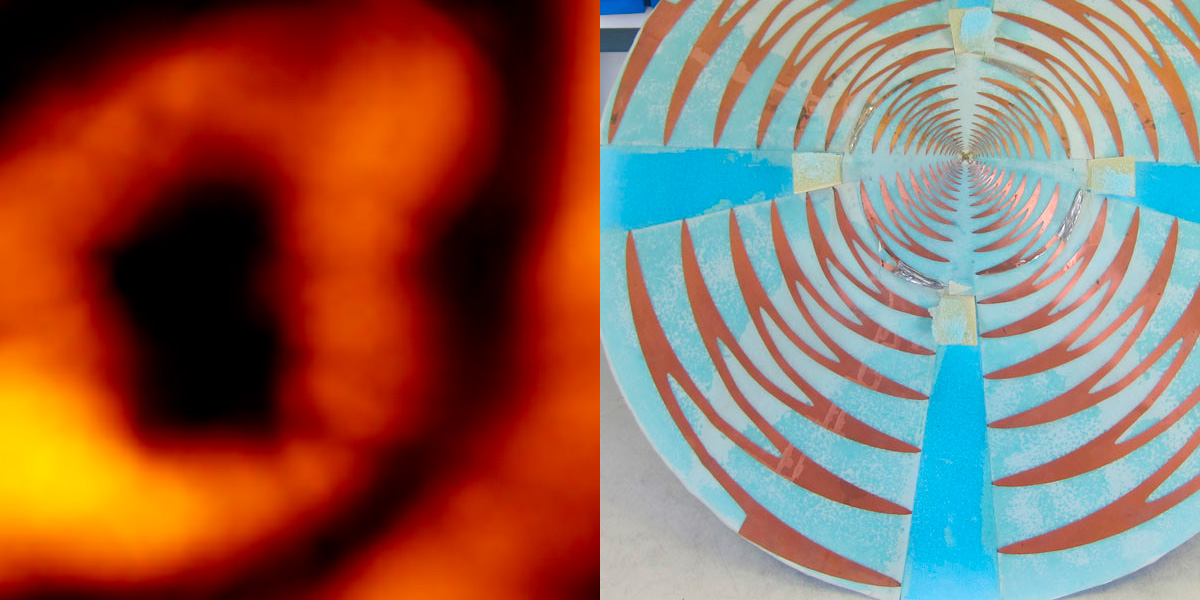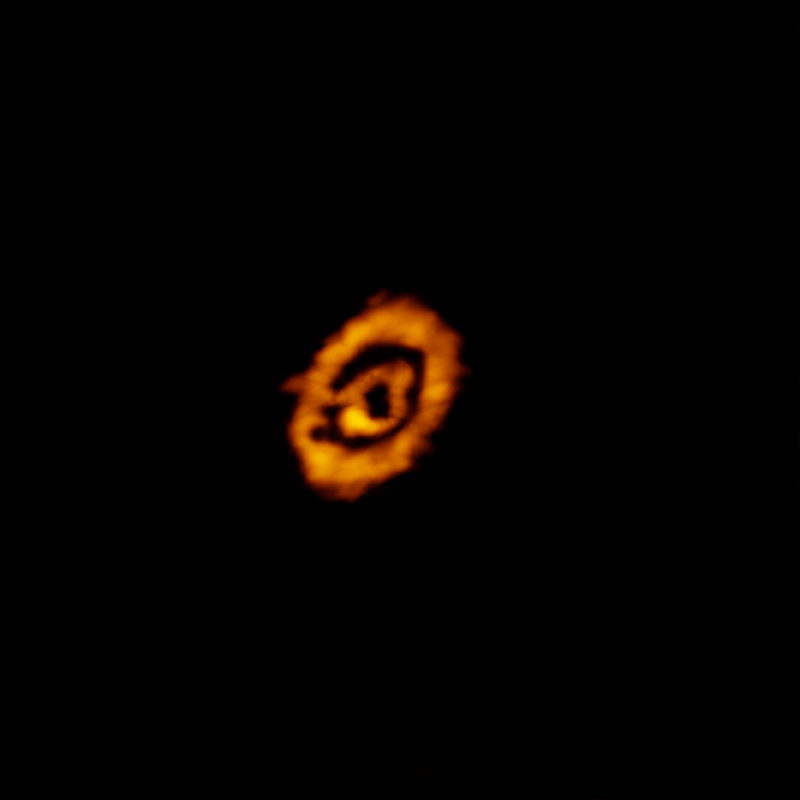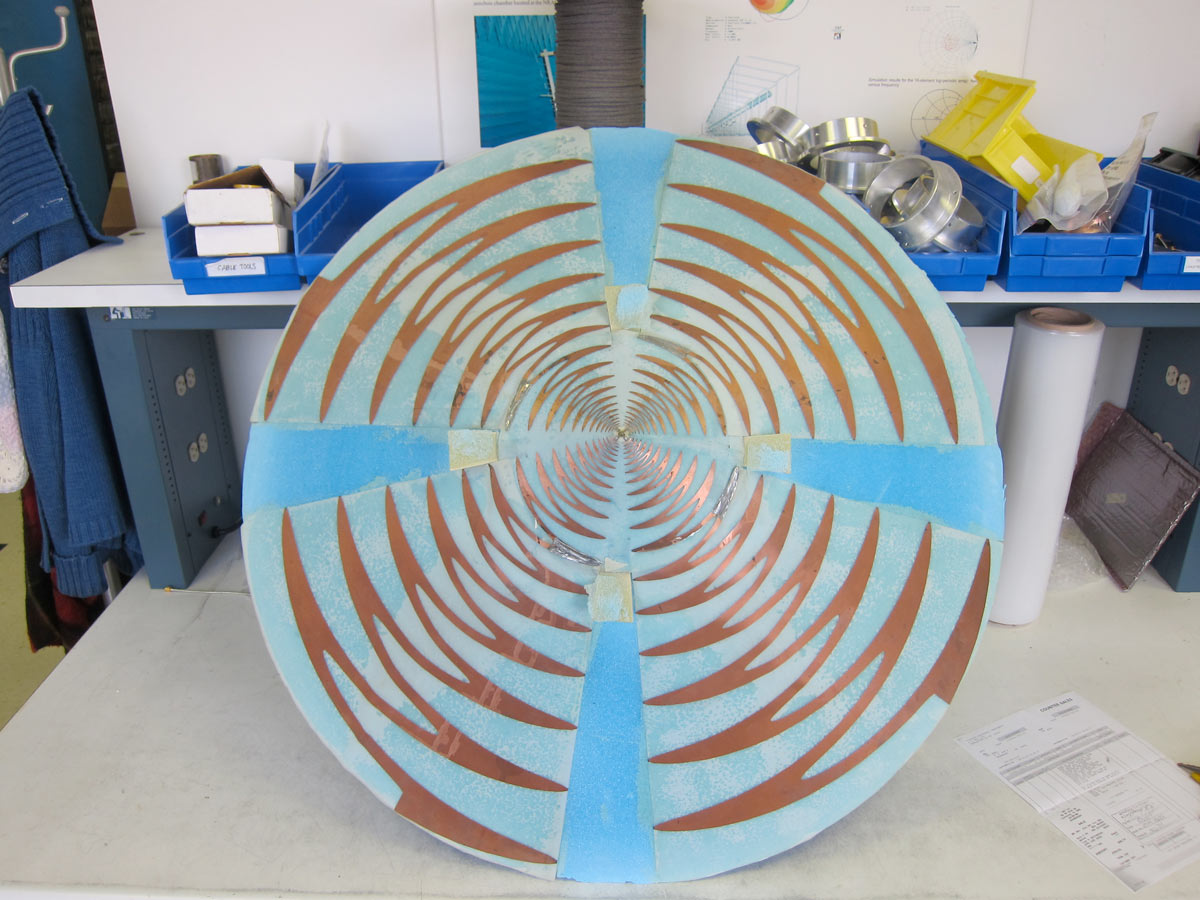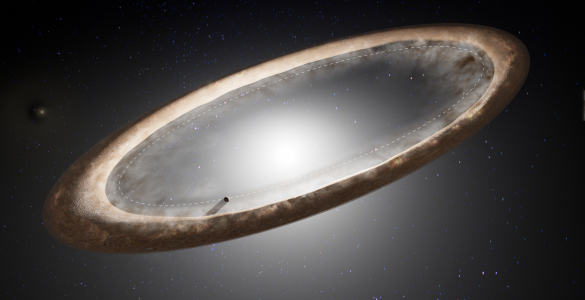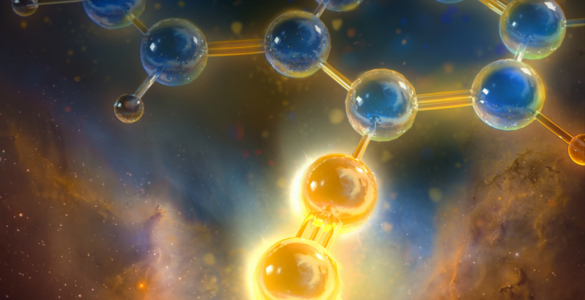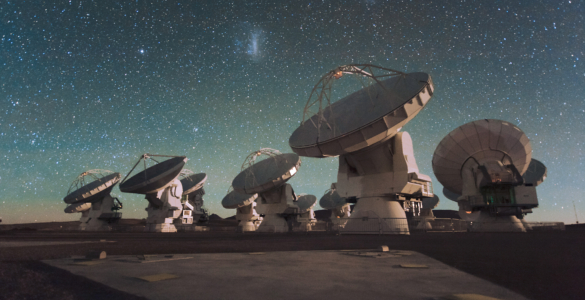Topics in This Issue:
ALMA discovers spectacular pair of molecular rings around Sun-like star.
Sinuous antenna achieves remarkable wide-band capabilities.
1. Astronomers See Surprising Chemistry in Molecular Rings around Young Star
Astronomers using the Atacama Large Millimeter/submillimeter Array (ALMA) have discovered two spectacular rings of molecules encircling the young, Sun-like star IM Lup. The rings are made up of one of the most common heavy ions (charged molecules) in space, DCO+ (deuterium, carbon, oxygen). In this molecule, deuterium has replaced the normal hydrogen atom of HCO+ in a process known as hydrogen-deuterium exchange. This chemistry reveals new insights into the conditions of the planet-forming disk surrounding this young star. “With ALMA we can directly observe this chemistry in disks that are right now in the process of making planets,” said Karin Öberg, an astronomer at the Harvard-Smithsonian Center for Astrophysics in Cambridge, Mass., and lead author on a paper published in the Astrophysical Journal. “The molecules have formed two spectacular rings. The inner one we expect to see; the outer one comes as a complete surprise and sheds new light onto the properties of a protoplanetary disk’s outer reaches.” The presence of a DCO+ ring nearest to the star, the astronomers note, comes from the right combination of low temperatures and abundant carbon monoxide (CO) gas, which is essential for the formation of DCO+. Closer to the star, conditions are too warm for DCO+ to form. Further out, the entire reservoir of CO freezes out, forming a layer of ice on dust grains and planetesimals. The presence of the outer ring implies that farther and farther from the star it not only gets colder and darker, as would be expected, but it also hits a point where the disk density is so low that some light from the host star can penetrate down to the midplane of the disk. This replenishes the reservoir of CO gas and restarts the production of DCO+. Heavy, deuterium-based molecules can thus form in more places around young stars than previously thought. This increases the utility of these molecules to tell us about the history of both our Solar System and other planetary systems in the making. “Heavy molecules are, in fact, interstellar messengers that tell us how and where different types of molecules form,” noted Öberg. “For example, based on an excess of heavy water in the Earth’s oceans we know that most of the Earth’s water comes from the pre-Solar nebula, so it’s actually older than the Sun!”
Reference: “Double DCO+ rings reveal CO ice desorption in the outer disk around IM Lup,” K. Öberg et al., 2015 September 4, Astrophysical Journal [http://iopscience.iop.org/article/10.1088/0004-637X/810/2/112].
2. Innovative Sinuous Antenna Earns Patent for NRAO Engineers
An engineering team at the National Radio Astronomy Observatory’s (NRAO) Central Development Laboratory (CDL) received a patent for a new wide-band radio antenna. This breakthrough technology combines both traditional and highly innovative fabrication techniques to create an antenna with exceptional simultaneous frequency coverage. The prototype antenna covers the 300 MHz to 3 GHz range, but the invention can be implemented in any similar range of radio frequencies, such as 2 GHz to 20 GHz, which would have a significant impact on commercial satellite communications and space situational awareness operations. The patent describes the design and placement of sinuous resonators – the part of the antenna that actually receives the radio waves – onto the surface of an inverted cone. The resonators form expanding wave-like bands snaking outward from the central focal point of the antenna. The entire apparatus sits atop a traditional ground plane: the base portion of an antenna. The steadily increasing width of the resonators allows the antenna to simultaneously receive a wide array of frequencies. Earlier wide-band antennas use a traditional planar design, which requires absorbers to make it unidirectional. These absorbers, however, add extra noise to the system and decrease effectiveness. The new design elegantly solves this problem, making it suitable for systems in which low-noise and wide bandwidth requirements are a priority, such as spread spectrum radio communications. This allows one antenna to replace many in practical use, thereby reducing costs. The wide-bandwidth applications of this technology also include radio astronomy, biomedical imaging, spectrum surveillance, and satellite communications, among others. U.S. Patent #9,054,516 was issued on June 9, 2015, to NRAO researchers Richard Bradley and Rohit Gawande. The CDL supports the evolution of NRAO’s existing facilities and provides the technology and expertise needed to build the next generation of radio astronomy instruments.
The National Radio Astronomy Observatory is a facility of the National Science Foundation, operated under cooperative agreement by Associated Universities, Inc.
# # #
Contact:
Charles Blue, Public Information Officer
(434) 296-0314; cblue@nrao.edu
The Atacama Large Millimeter/submillimeter Array (ALMA), an international astronomy facility, is a partnership of the European Organisation for Astronomical Research in the Southern Hemisphere (ESO), the U.S. National Science Foundation (NSF) and the National Institutes of Natural Sciences (NINS) of Japan in cooperation with the Republic of Chile. ALMA is funded by ESO on behalf of its Member States, by NSF in cooperation with the National Research Council of Canada (NRC) and the National Science Council of Taiwan (NSC) and by NINS in cooperation with the Academia Sinica (AS) in Taiwan and the Korea Astronomy and Space Science Institute (KASI).







